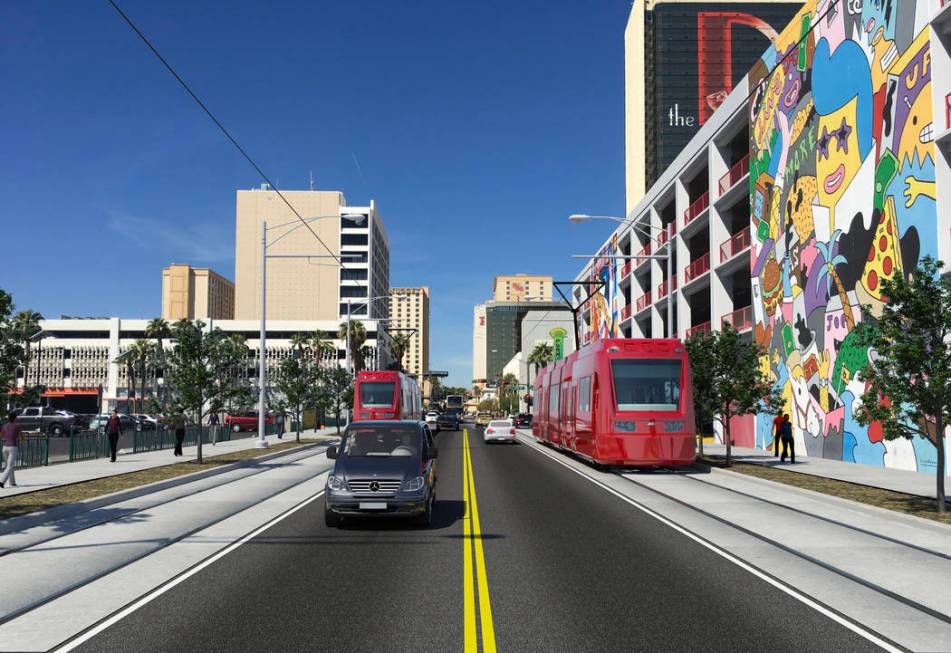RTC hears public feedback on 3 options for Maryland Parkway’s future

With transportation officials ready to decide if light rail is in Maryland Parkway’s future, residents sounded off on their concerns for the important Las Vegas corridor.
The Regional Transportation Commission of Southern Nevada hosted the first of five public hearings Wednesday for the three proposed options for the busy corridor: light rail, a bus rapid transit system featuring dedicated bus lanes that could be used as turn lanes when buses are not present, or enhancing the current bus route 109.
“I thought this was a fantastic meeting, it was a packed house,” said David Swallow, senior director of engineering and technology for the commission. “They identified their concerns and they asked very pointed questions. You can tell they took the time to study this project ahead of coming here.”
After the public hearing period ends March 7, the feedback will be compiled and summarized and taken to the RTC board as early as its April 11 meeting, Swallow said. After the preferred mode is chosen, the RTC will submit the choice to the Federal Transit Administration this summer and then seek funding for the project.
Construction on the desired project is tentatively planned to begin in 2022, with the project taking up to 2.5 years to complete, depending on the mode chosen.
The project would link McCarran International Airport, UNLV, several hospitals and medical centers and retail and commercial developments. Its 8.7-mile route would stretch along Maryland Parkway to Carson Avenue in downtown Las Vegas, to Casino Center to the Bonneville Transit Center, then loop around the Medical District and back, according to the RTC.
The area along the route has 90,000 residents and sees 35,000 vehicles and 9,000 transit riders daily. There are 25 transit connections along the route, including the nine busiest in the Las Vegas Valley.
Titus takes an interest
Rep. Dina Titus, D-Nev., represents District 1 in the Las Vegas Valley, which includes the area where the project is slated to occur.
“What happens to Maryland Parkway is very important to me and my constituents and the economy of the entire valley,” Titus said at Wednesday’s public meeting.
The three options, which all would include pedestrian and bicycle facilities, vary widely in possible costs. The light rail plan could cost as much as $750 million while the bus rapid-transit plan could cost up to $335 million and the upgrading of route 109 is estimated to cost about $29 million, according to the RTC.
Of the three options, Titus hasn’t definitively decided which she believes is best, but one sticks out to her over the others.
“I haven’t supported an option, but I’m very supportive of light rail,” Titus said. “I just want to be sure that there’s public input, we have the resources needed and that it’s street smart, and accommodates all different kinds of users.”
Attendees of the meeting raised a variety of concerns, including security worries of the possible light rail, construction disruption and the usefulness of a light rail system, among others.
Questions about funding
Several in attendance asked about funding for the project. Although the funding for whichever option is chosen has not been identified, Swallow assured residents it’ll be figured out, likely without raising taxes.
“We do have local funds already appropriated (Fuel Revenue Indexing) to the project, but we want to go compete for funds at the federal level,” he said. “We think this is a very strong project and we want to compete for those funds.”
Federal funds could account for up to half of the project’s cost, with some federal funding already earmarked for Maryland Parkway and other amounts possible through competitive grant programs, Swallow said.
Two of the options — bus rapid transit and light rail — include dedicated lanes that would serve as defacto right turn lanes for other motorists commuting the stretch.
Eliminating a regular traffic lane on an already busy road has several residents in the area worried.
Joyce Duvall, who’s lived off Maryland Parkway near Sunrise Hospital her entire life, said more studies are needed on the effect the project might have on other streets in the area, especially regarding the dedicated lane.
Duvall said the large amount of residents in the area who don’t use public transportation and opt to use personal vehicles would be hindered by the dedicated lanes.
“Having nearly been hit by buses pulling out without looking creates a problem,” said Duvall, who hasn’t decided which option she supports. “If people use the right lane to pass traffic by, not that its legal but you will see people do that, because there’s no place else to go. It’s the reality of this town.”
Contact Mick Akers at makers@reviewjournal.com or 702-387-2920. Follow @mickakers on Twitter